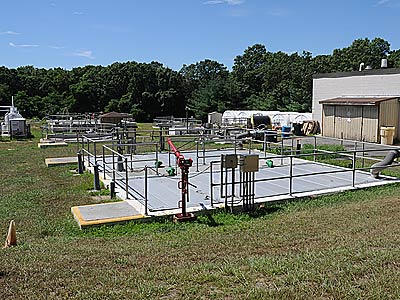Citations at Waste Plant Cause Stink

Odor emanating from East Hampton Town’s septic waste treatment plant often permeates the air along Springs-Fireplace Road. In recent weeks, the smell has been stronger and more stomach-churning, according to those who happen to be nearby. “As the owner of a food store, you can imagine what my thoughts are,” Bill Hall, who operates the One Stop Market just across the street, told the East Hampton Town Board at a meeting on Tuesday. “It’s really bad. When you have weather like this, it’s particularly bad,” he said on a hot August morning. Mr. Hall said the plant had “been an ongoing problem for 20 years. It hasn’t worked efficiently since it went in.” Recently, making a stop at his own store for a bite to eat, Mr. Hall said, the smell was staggering. “I was sick to my stomach.” He urged the board to take a stand and shut the treatment plant down. The town pays a private contractor, Severn Trent, almost $80,000 a month to operate the plant. In May, the town was cited by the State Department of Environmental Conservation for discharging wastewater into the ground that exceeded established limits and given a deadline of June 23 to submit a corrective action plan. According to a certified letter from the D.E.C. to Town Supervisor Bill Wilkinson dated May 23, monitoring reports covering February 2008 through March 2011 indicated excessive levels of nitrogen, mercury, iron, and other elements. The violations “appear to be an ongoing problem,” William H. Spitz, the D.E.C. regional water manager, wrote. State law sets a maximum penalty of $37,500 for each violation, which can compound daily, he noted. Four times in March, discharge from the plant had exceeded the parameters for mercury, iron, total suspended solids, and “biological oxygen demand.” According to Neal Sheehan, the former head of East Hampton’s Sanitation Department, who is now with the Town of Huntington, the measurement can be an indication of the degree to which the septic waste has been treated. At the request of the town board last year, the town’s budget and financial advisory committee had studied the operation of the scavenger waste plant and alternatives for the future. Its preliminary report was given to the town board in March, and in April the board acted on one of the committee’s primary recommendations: It put Severn Trent on notice that its contract would not be continued when the term expires in November. Just what might happen to the plant if Severn Trent’s contract is out has not been determined. Mr. Wilkinson said Tuesday that he had just asked the Planning Department to provide the board with information about the town’s options. The board must decide, the supervisor said, “whether we put in incremental dollars, whether we lease it to somebody, or whether we shut it down.” Among the considerations, he said, would be the impact on residents if cesspool pump-out companies have to drive out of town to dump septic waste, which would likely result in a cost increase. The town had received a separate letter from the D.E.C. in May for failing to submit annual documentation on time. Neither May letter was discussed in public, with D.E.C. violations cited as the topic of an executive session. Johnson Nordlinger, Mr. Wilkinson’s assistant, said yesterday that the town had now engaged Cameron Engineering, a consultant, to develop the corrective plan demanded by the D.E.C. It is to be submitted by Aug. 23. Speaking at Tuesday’s meeting, Mr. Hall said the smell not only affects the complex of shops across the street, but neighboring residential communities. And, for the residents of Springs who travel past the plant repeatedly, “that’s not a welcome sign for Springs and for the people of Springs.” Mr. Hall said he had called the town’s attention to problems at the plant in the 1990s but “nothing has been done since then.” “I consider it a health hazard,” he told the board. “It has to affect my business.” One Stop has been successful, he said, “but sometimes I wonder how successful I could be if people got out of their car and still had an appetite when they got to the door.” Mr. Wilkinson acknowledged the problem. “I went up there one day, after a complaint,” he said, “and it took me two weeks to get rid of the headache.” “The fix to that is basically a few filters that we have to pay for,” Councilwoman Julia Prince said. She had already brought up the odor problem at a board meeting on Saturday. “I would love to solve the problem,” Councilwoman Theresa Quigley said. But, she added, “I don’t even know if we know definitively what the cause is.” “I’ve called there several times; they say it’s operating at their required performance level,” Mr. Wilkinson said. In addition to recommending that Severn Trent be put on notice, the advisory committee’s report asked the town to evaluate environmental conditions at the plant. Mentions of possible environmental violations prompted the town board to ask Arthur Malman, the committee member delivering the report at a board meeting in early spring, to discuss it in executive session. Although questions were raised about whether an executive session was appropriate under the state open meetings law, the town attorney told the board the matter should not be discussed in executive session with Mr. Malman, but could discuss operation of the plant privately with a technical adviser from Cameron Engineering.
